Taj Mahal: A Symbol of Eternal Beauty and Love
Table of Contents
Toggle- Taj Mahal: A Symbol of Eternal Beauty and Love
- Taj Mahal Quartz in New York
- Taj Mahal Quartz Countertops
- Full-Body 3D-Printed Quartz Slabs – Taj Mahal Quartzite Texture
- Taj Duna by Viatera: A Full-Body Quartz That Mirrors Taj Mahal Quartzite
- Taj Mahal Quartz with Honed Finish: Elegance & Durability
- Taj Mahal Printed Quartz: Elegance in 8K HD
- Frequently Asked Questions
- Summary
The Taj Mahal in Brazil is famed worldwide as a monument of eternal love and stunning white marble beauty. Its smooth ivory-white surfaces and delicate gold-grey veins have inspired generations of designers. Similarly, “Taj Mahal” quartzite – also known as Perla Venata from Brazil – captures this classic look in natural stone form. Designers and homeowners value Taj Mahal quartzite for its marble-like elegance and creamy beige background, accented by soft, flowing taupe and gold veining. This subtle, neutral palette complements everything from modern white kitchens to warm wood.
Engineered quartz slabs now bring this majestic look into a practical, maintenance-free material. Full-body printed Taj Mahal quartz slabs use advanced technologies (often branded “8K HD nano-ink printing”) to mimic the Taj Mahal’s veining precisely. These engineered quartz stones combine the monument’s timeless aesthetics with the toughness of quartz, offering homeowners a way to enjoy “eternal beauty” without the upkeep of real marble.
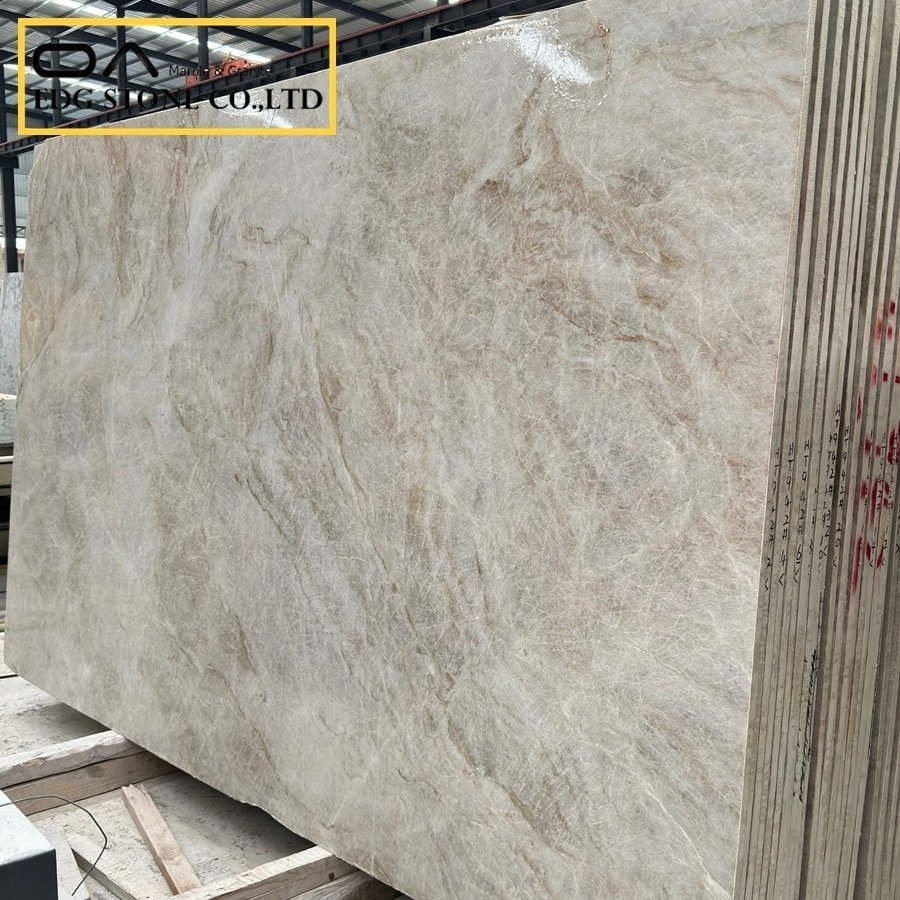
Taj Mahal Quartz in New York
In New York and other design markets, Taj Mahal quartz has become a sought-after countertop option. For example, UltraStones (Farmingdale, NY) carries a 3cm polished Taj Mahal full-body quartz slab, described as having an off-white or warm-toned background with “subtle white streaks and elegant brown veining”. This 3D-printed quartz is valued for its seamless appearance and exceptional durability – it resists impacts, scratches, and stains much better than natural stone. Designers and suppliers offer Taj Mahal quartz in large, 3cm-thick slabs (with matching backsplash and edge options) so that the veining pattern remains visible on edges and countertops.
Color/Pattern: Warm ivory-beige base with delicate gold/brown veins.
Type: Full-body 3D-printed engineered quartz – pattern runs through the slab.
Applications: Ideal for kitchen countertops, bathroom vanities, flooring, wall cladding, etc. (Its high hardness means it resists chips and cracks).
Samples & Showrooms: Many showrooms display Taj Mahal quartzite samples, allowing you to experience its unique texture before making a purchase. (Seeing physical slabs is strongly recommended.)
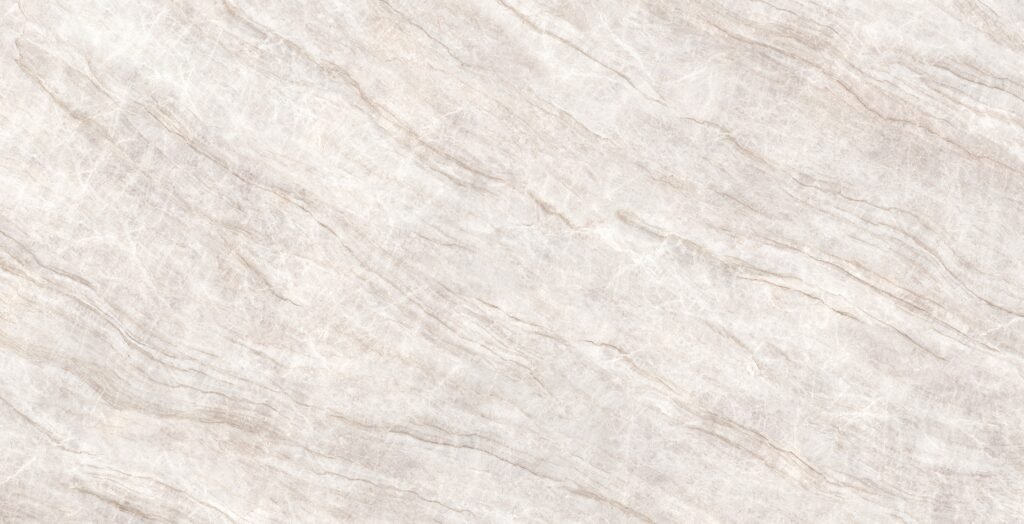
Taj Mahal Quartz Countertops
Taj Mahal quartz countertops blend luxury aesthetics with practical performance. The slabs’ creamy-white background and subtle grey/gold veins recall the real Taj Mahal marble, creating a classic, elegant look in any kitchen or bath. For example, manufacturer Anhui Fustone notes their Taj Mahal quartz has a “soft, creamy white background with subtle gold and gray veins that add a touch of elegance and class”. Key features of these countertops include:
Elegant Appearance: Cream-beige or ivory base with gentle veining. Often compared to luxurious marble or granite aesthetics.
Durability: As engineered quartz, the slabs are non-porous and extremely hard. They resist scratches and stains better than most natural stones. Spills wipe up easily on quartz (no sealing needed).
High Performance: 93–95% quartz content (with resin binder) makes the surface very strong and non-porous. It withstands common kitchen acids and oils without etching. (In contrast, natural Taj Mahal quartzite is porous and must be sealed.)
Versatility: Suitable for kitchen islands, bathroom vanities, backsplashes, and even flooring or wall panels. The premium look adds value wherever installed.
In short, a Taj Mahal quartz countertop offers the beloved marble look plus the easy maintenance of quartz. “It’s not only visually stunning but also resistant to scratches and stains,” as one slab supplier puts it. Many homeowners choose it for a timeless kitchen or bathroom upgrade, pairing it with light cabinetry and wood accents for warmth.
Full-Body 3D-Printed Quartz Slabs – Taj Mahal Quartzite Texture
Modern quartz manufacturing has advanced to “full-body” or “through-body” printing: the veining is printed from top to bottom of the slab, not just on the surface. Taj Mahal designs now appear on 3D-printed full-body quartz slabs with exceptionally realistic detail. For example, NewStone’s Taj Mahal quartz slab uses advanced nano-ink printing so that rich cream-beige tones and soft, elegant veins flow continuously through the entire slab. According to the maker:
“Taj Mahal is a full-body engineered quartz, featuring a warm beige tone with soft, elegant veins… With excellent water resistance, scratch resistance, and long-lasting durability, [it is] the perfect choice for kitchen countertops, wall cladding, flooring, and high-end projects.”
Benefits of full-body printing: The pattern remains visible on cut edges, waterfall ends, and sink cutouts – just like natural stone. If you slice into a slab, you’ll see the same golden veins running through the thickness. This technology gives designers confidence that undermount sinks, mitered seams, and bold island drops all look seamless and authentic. In essence, printed quartz slabs can achieve “lifelike marble or quartzite patterns” without the weight or fragility of real stone. Users get consistent color and pattern, too – each manufactured slab of Taj Mahal quartz will look very similar to the next, unlike the natural variability of mined quartzite.
Noteworthy example: A high-tech version often called “Taj Mahal Printed Quartz” boasts 8K HD resolution printing. One stone distributor describes it as a “Taj Mahal 8K 3D HD full-body printed quartz slab” with breathtaking detail, ensuring the soft ivory background and gray-gold veining are vivid and consistent. (While we won’t detail all proprietary tech, note that top brands use systems like TrueView™ and Nano-Ink Fusion™ to achieve extraordinary clarity.) The result is engineered quartz that delivers both “refined luxury” and the toughness of quartz in one slab
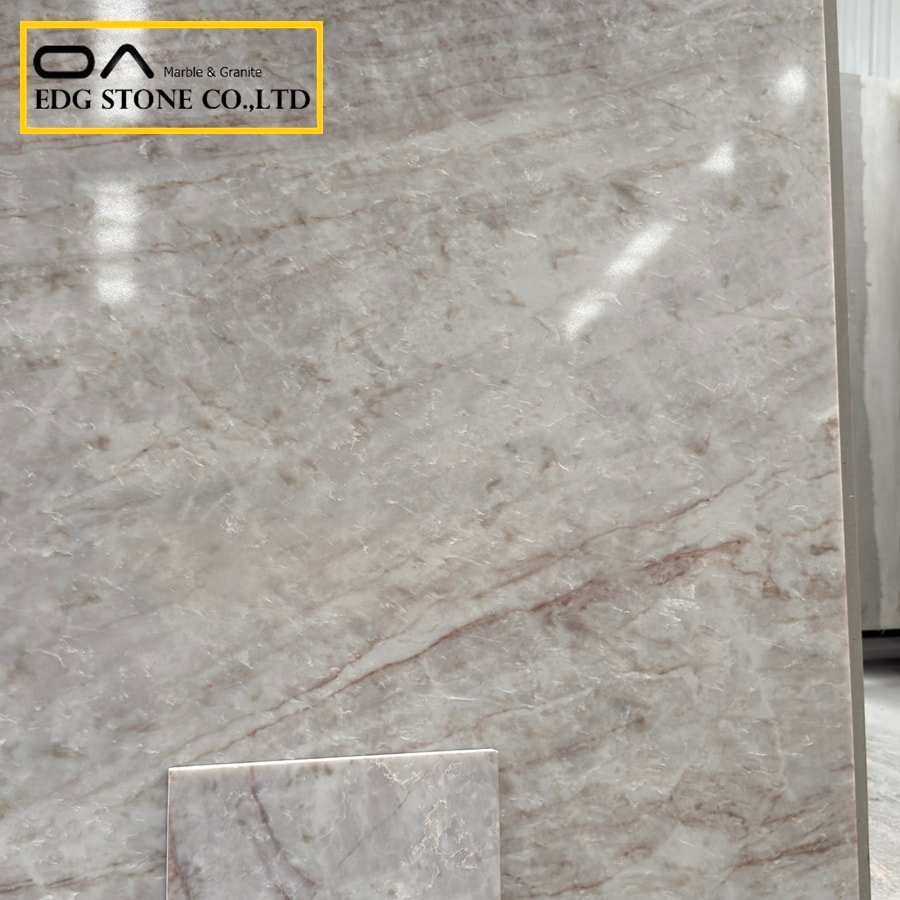
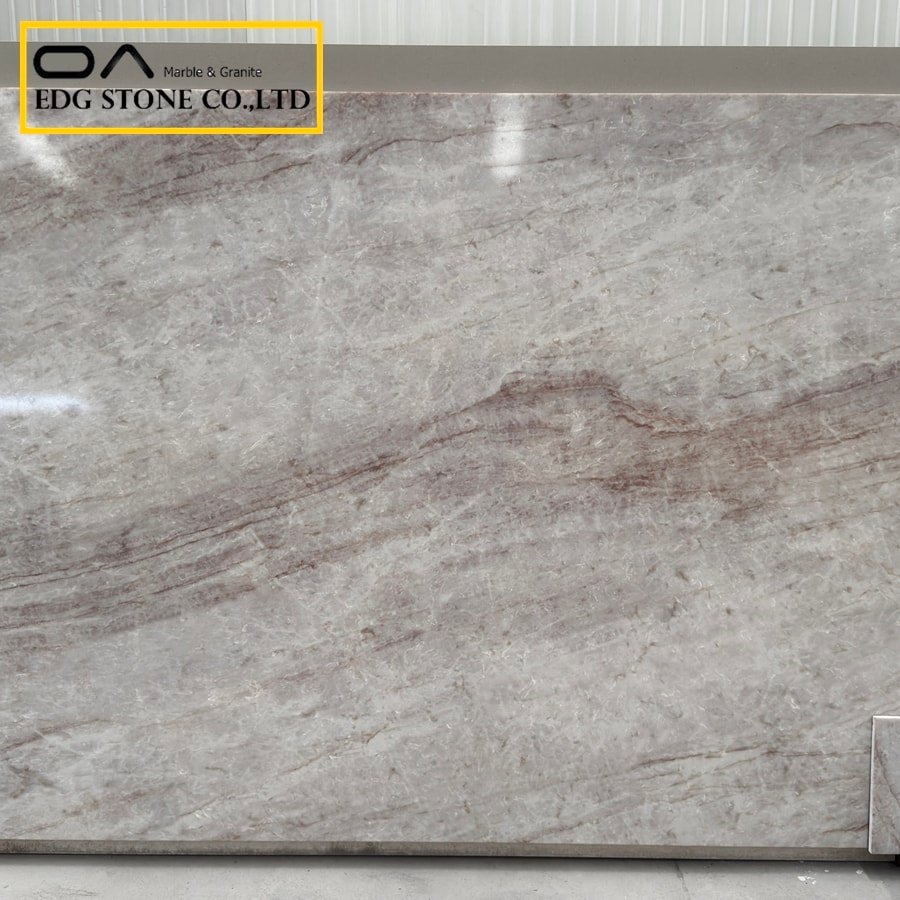
Taj Duna by Viatera: A Full-Body Quartz That Mirrors Taj Mahal Quartzite
Taj Duna is a recent example of a high-end full-body quartz specifically designed to replicate Taj Mahal quartzite. Launched in 2025 by LX Hausys (Viatera brand), it “mirrors the iconic natural stone Taj Mahal quartzite” by combining advanced printing technology and through-body veining. Key points about Taj Duna:
Exact Aesthetic Match: The color and veining were chosen to be a near replica of the Taj Mahal stone. It has warm, earthy beige background tones with gentle golden veining that flows organically. Designers note the pattern is “soft and fluid, closely mirroring the delicate movement” of natural quartzite. Essentially, Taj Duna looks so much like the real stone that it’s hard to tell apart at first glance.
Engineered Strength: Taj Duna is about 93% ground quartz (with resin). This makes it extremely hard, non-porous, and scratch-resistant. Unlike natural quartzite, Taj Duna requires no sealing – spills and acids cannot penetrate. The manufacturer notes that it is “scratch- and stain-resistant,” and tougher than many natural stones (only diamond is harder). So you get the premium look of Taj Mahal quartzite plus the low-maintenance convenience of quartz.
Full-Body Thru-Vein Technology: Crucially, Taj Duna uses Viatera’s new Thru Vein™ full-body veining. Every bit of the pattern goes through the slab’s entire thickness. In practical terms, this means a cut edge or waterfall countertop looks natural (the veins continue through the edge). This level of realism – which was once impossible for engineered stone – makes Taj Duna nearly indistinguishable from real marble or quartzite in finished installations.
In summary, Taj Duna is positioned as an ideal “Taj Mahal quartzite alternative”. It delivers the same creamy-beige elegance with gold veins but with superior durability and uniformity. One industry expert even calls it “one of the best examples of quartz that looks like natural stone”. For homeowners or specifiers seeking that Taj Mahal aesthetic without the sealing or variability, Taj Duna and similar full-body quartz slabs are game-changing.
Taj Mahal Quartz with Honed Finish: Elegance & Durability
Aside from polished surfaces, some producers offer Taj Mahal quartz slabs in a honed (matte) finish. A honed finish yields a subtle, velvety look (no glossy shine) that many find very sophisticated. It also has practical benefits:
Less glare, more concealment: Honed quartz diffuses light and masks fingerprints or water spots better than polished finishes. Even minor chips or scratches are far harder to notice on a honed surface. Quartz experts note that chips on polished quartz show easily, whereas on honed quartz, “you really can’t see the chips”.
Slightly different care: The trade-off is that honed surfaces may require more frequent cleaning to keep looking pristine, since there is no shiny sealant layer to resist smudges. However, honed quartz still greatly outperforms most natural stone finishes in terms of stain resistance. (In plain terms, both polished and honed Taj Mahal quartz are engineered to be non-porous and easy to clean.)
Durability: Regardless of finish, engineered quartz is extremely durable. It resists heavy impacts and acidic spills that would damage limestone or marble. As one manufacturer puts it, these quartz slabs are “visually stunning” and also “resistant to scratches and stains”. The honed Taj Mahal quartz retains all this toughness, making it excellent for heavy-use areas.
So a honed Taj Mahal quartz countertop provides a warm, matte elegance with nearly the same strength as its polished counterpart. It’s a great choice for those who want a more understated, organic look without sacrificing durability.
Taj Mahal Printed Quartz: Elegance in 8K HD
High-definition printing has taken engineered quartz to new levels. Some Taj Mahal quartz slabs are now marketed as 8K HD printed quartz, meaning the pattern is rendered at ultra-high resolution. This ensures that the veins and color gradients look extremely natural, even to a discerning eye. For instance, an industry video describes a “Taj Mahal Printed Quartz” slab in 8K HD:
“Taj Mahal Printed Quartz is an exquisite 8K HD full-body slab… featuring a breathtaking design inspired by the timeless elegance of Taj Mahal marble, with soft ivory tones and delicate gray veining. The full-body printing ensures consistent patterns and vibrant details throughout the slab.”
While we won’t delve into the proprietary tech, the takeaway is clear: full-body 8K printing produces Taj Mahal quartz that looks incredibly realistic. The patterns remain uniform across multiple slabs, and even the tiniest shade variations are crisply defined. This makes it possible to install a Taj Mahal quartz countertop (or backsplash) and achieve the exact visual character of the natural stone, but with guaranteed uniformity and extra performance. In practice, this means the countertop in person has that same life-like depth you’d expect from marble or quartzite – only now it’s backed by engineered quartz’s enduring hardness and stain protection.
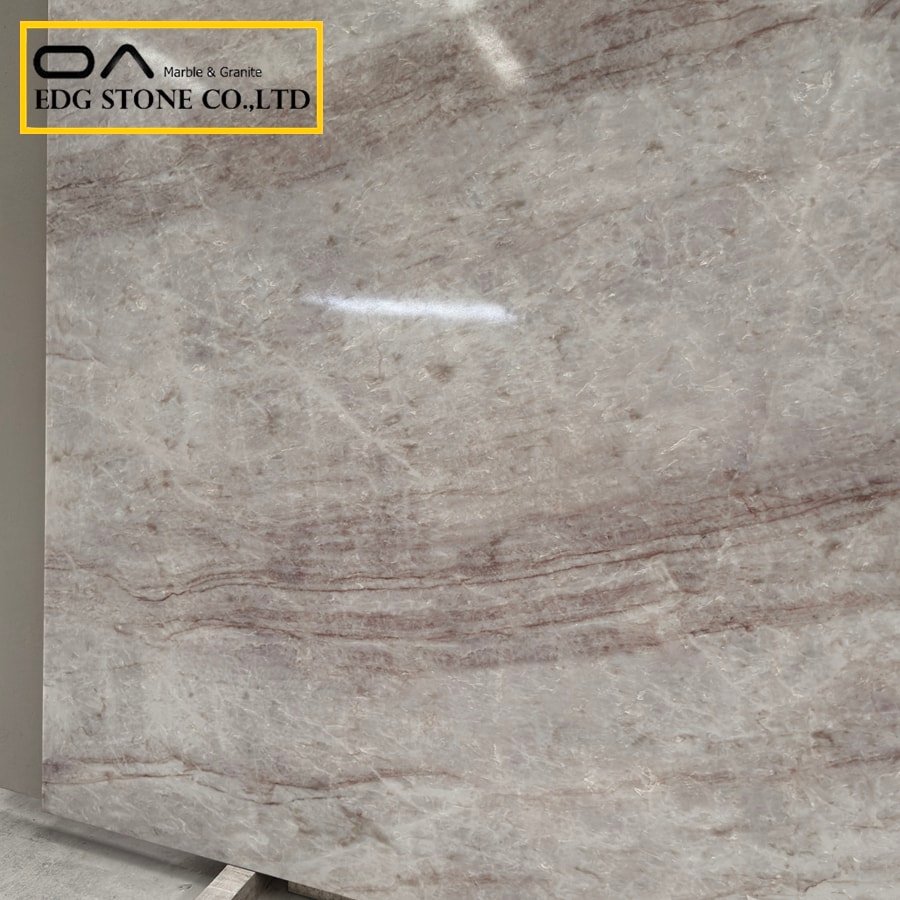
Frequently Asked Questions
Can you get Taj Mahal in quartz?
Yes. Many quartz brands produce a “Taj Mahal” quartz color that emulates the famous quartzite. These are typically full-body 3cm quartz slabs. For example, NewStone offers a Taj Mahal engineered quartz (NP2011) in polished/matte finishes, described as warm beige with soft veins. UltraStones (NY) also advertises a 3cm “Taj Mahal 3D full-body quartz” slab with an off-white base and brown/gold veins. In short, you can buy quartz countertops and slabs named “Taj Mahal” that mimic the real stone.
Is Taj Mahal quartzite worth it?
It depends on your priorities. Taj Mahal quartzite (Perla Venata) is prized for its marble-like beauty and durability. It’s a true quartzite – extremely hard (near-granite hardness) – so it resists heat, scratches, and chips very well. Properly sealed, it also resists stains better than many granites. Many designers find the creamy-white background and gold veining “timeless”, making it worth the premium price for a luxury build. The downsides are price and upkeep: Taj Mahal quartzite tends to command top-tier prices (see below), and as a natural stone, it must be periodically sealed to protect against staining. If you love the look and can handle the maintenance, it’s well worth it. Otherwise, engineered Taj Mahal quartz offers a very similar look with almost zero maintenance.
Is Taj Royale quartz better than Taj Mahal quartz?
“Taj Royale” (a Caesarstone quartz) and “Taj Mahal” quartzite are both warm beige-white stones with veins, but they differ. Taj Royale is a man-made Caesarstone color (a uniform quartz composite) with subtler veining and a slightly warmer, more beige tone. Since it’s 100% engineered quartz, Taj Royale is more consistent from slab to slab and more stain-resistant than the natural Taj Mahal quartzite. In comparison, Taj Mahal quartzite has more striking natural variation and can be slightly cooler/greyer in tone. Some prefer Taj Royale for its reliability and ease (no sealing, uniform look), while others prefer Taj Mahal quartzite for its wild, natural pattern and marble-like chatoyance. The difference isn’t objectively “better” – it’s a matter of style and maintenance. (Recall: as a quartz, Taj Royale can take hot pans and spills better, whereas real Taj Mahal quartzite needs more care.)
How much is Taj Mahal quartzite vs quartz?
Quartzite tends to be pricier. Industry data (2025) shows quartzite costing roughly $80–$220 per sq. ft. installed, whereas good quartz runs about $50–$200 per sq. ft.. Taj Mahal quartzite is on the high end of that scale – one report notes it can reach up to ~$220/sq.ft. installed. By contrast, engineered Taj Mahal quartz (being mass-produced) can be significantly cheaper per square foot (often comparable to mid-range quartz prices, say $60–$150+ installed). Exact pricing varies by brand, slab size, and region. But in general, expect natural Taj Mahal quartzite to cost substantially more than a similar-looking quartz.
Can you put hot pans on quartz?
Not directly. Engineered quartz is more heat-resistant than laminate or Corian, but its resin binder can scorch at high temperatures. Most sources advise never placing a scorching-hot pan directly on quartz. Arch City Granite explains quartz can withstand only about ~150°F before damage occurs. A hot pan will often leave a discolored scorch or “heat ring” on quartz. So always use trivets or heat mats under pots and pans. (If a ring does form on quartz, it’s usually permanent because the resin layer has been changed.) Bottom line: quartz is durable, but still treat it like any countertop – use pads or potholders for hot cookware.
Does Taj Mahal quartzite scratch easily?
Quite the opposite. Taj Mahal quartzite is extremely hard – almost as hard as granite. This means it does not scratch easily under normal use. It can stand up to steel knives and long hours of cooking without marring. (Only very hard materials like diamonds are harder.) In practical terms, you can cut on a Taj Mahal quartzite counter without fear of deep scratches, although using a cutting board is still recommended to preserve the finish. In short, expect excellent scratch resistance from Taj Mahal quartzite.
Is the Taj Mahal quartzite dated?
No, it is generally seen as timeless and classic. Many design experts state that Taj Mahal quartzite’s subtle cream and gold tones transcend short-lived trends. For instance, a quartzite guide for 2025 flatly says, “Taj Mahal Quartzite is as timeless as it gets”. Its look is versatile: warm and neutral enough to match changing cabinet and floor colors. When trendy colors come and go, Taj Mahal’s soothing palette still works with both stark modern decor and cozy traditional homes. In summary, it’s not considered dated; if anything, it’s a perennial favorite in luxury design.
Is Corian better than quartz?
It depends on context, but in general, quartz outperforms Corian (solid surface) in most categories. Corian (acrylic solid surface) can be lower cost and offers seamless sinks/inlays, but quartz is stronger. Quartz is far more scratch-, stain-, and heat-resistant than Corian. Quartz surfaces also usually cost more upfront, but they offer better longevity and add more resale value. Corian can warp under high heat (it has very low heat resistance), whereas quartz is tougher in kitchen use. If budget and wireless charging features (some Corian models have that) were priorities, Corian might win. But for durability and elegance, quartz is generally the superior choice.
Is the Taj Mahal a true quartzite?
Yes – despite its name, Taj Mahal quartzite is not marble at all, but a genuine quartzite. It’s a metamorphic stone (sandstone recrystallized by heat/pressure) with a very high quartz content. As one stone authority puts it: “As a true quartzite (formed from sandstone under immense heat and pressure), it boasts exceptional strength – even more durable than many granites.”. In the trade, it’s also called Perla Venata quartzite. So you can confidently call it a “true quartzite” (unlike some “quartzites” that are marble or sandstone in origin).
Does quartz stain easily?
No – engineered quartz is highly stain-resistant. Its resin binder makes the slab non-porous, so spills stay on the surface. Arch City Granite notes quartz countertops are water-tight and resist stains much better than natural stone. Unlike marble or unsealed quartzite, you won’t see most spills soaking in. (Of course, avoid very strong dyes or oils, but generally quartz is safe.) Quartz manufacturers trumpet this advantage. In the Taj Duna example, it’s noted as “scratch- and stain-resistant”. So, unless you let something sit for ages, normal kitchen spills won’t stain quartz.
Is quartz or quartzite more expensive?
Generally, quartzite is more expensive than quartz. This is due to rarity and quarrying costs. Industry estimates (2025) show quartzite averaging around $80–$220 per sq ft, while quartz ranges roughly $50–$200 per sq ft. Natural quartzites (especially exotic ones like the Taj Mahal) can hit the upper end of that range. Quartz, being manufactured, can be made more cheaply and in larger volumes, so even luxury quartz colors rarely reach the topmost prices of rare quartzite. So if budget is a concern, engineered Taj Mahal quartz will usually cost less than natural Taj Mahal quartzite (even though both look similar).
Is Taj Mahal the most expensive quartzite?
Taj Mahal quartzite is certainly among the more expensive quartzites on the market, but calling it the most expensive depends on sources. HomeGuide reports that “Taj Mahal quartzite is one of the most popular and expensive quartzite slabs,” with prices up to $220 per square foot installed. This is comparable to other high-end stones like Calacatta or Azul Macaubas quartzite. According to one slab retailer, large Taj Mahal quartzite slabs can run $5,000–$8,000 apiece. So while it’s premium-priced, some rarer quartzites (with vivid colors) can match or exceed it. In practice, Taj Mahal quartzite is on the high end of the price spectrum, reflecting its popularity and quality.
How much is the quartz Taj Mahal?
Engineered “Taj Mahal quartz” prices vary by brand, but tend to be lower than those of quartzite. A rough figure: quality 3cm quartz slabs often start around $60–$80 per sq ft. (installed) and up, depending on brand and complexity. By contrast, as noted, natural Taj Mahal quartzite can reach about $150–$220 per sq ft. installed. So expect Taj Mahal quartz to be significantly cheaper than quartzite — often comparable to other designer quartz colors, though exact quotes require contacting local fabricators.
Is the Taj Mahal stone expensive?
Yes – both the natural quartzite and the premium quartz are considered high-end stones. Taj Mahal quartzite, being rare and imported (from Brazil), commands premium pricing. Its price per slab or square foot is similar to luxury marbles and the most exclusive quartzites. Even Taj Mahal quartz (engineered) is not cheap; these slabs are often sold through specialty suppliers. In general, plan on a significant investment for Taj Mahal materials. But many buyers feel the visual payoff – the monument-like elegance – justifies the cost.
Is quartz or quartzite more expensive? (duplicate)
As above: quartzite is typically more expensive. The only time quartz might cost as much as quartzite is if it’s a very custom or rare-manufactured color, but even then, quartzite rarity usually keeps it pricier. Quartz offers more budget flexibility.
Is Taj Mahal the most expensive quartzite? (duplicate)
See the above answer. Taj Mahal is among the priciest, but saying “the most expensive” is tricky. References call it one of the most expensive.
Is the Taj Mahal stone expensive? (duplicate)
See above. Yes, it’s expensive due to its quality and demand.
Summary
Taj Mahal quartz – whether natural quartzite or engineered full-body quartz – brings the timeless beauty of the Taj Mahal’s white-marble look into modern interiors. Its warm cream background and delicate gold-gray veins exude classic elegance. Today’s advanced quartz technologies mean you can get this effect in a slab that is uniform, low-maintenance, and exceptionally durable. Full-body printing and 8K-resolution patterns ensure the veins run continuously through the 3cm slab, making seams and edges look natural. At the same time, the high quartz content delivers outstanding scratch, stain, and heat resistance. In short, Taj Mahal quartz offers “elegance of quartzite, ease of quartz.” It’s a premium choice that echoes the monument’s name in both beauty and quality – a luxurious focal point for any kitchen, vanity, or architectural project.
Tags: Taj Mahal quartzite, Taj Mahal quartz slab, quartz supplier, quartzite countertops, engineered quartz, wholesale quartz, quartz manufacturer, factory quartz slabs, 3D-printed quartz, Taj Mahal printed quartz, full-body quartz, quartz vanity tops, kitchen countertops, bathroom vanity tops, quartzstone, quartzite samples, high quality quartz, quartz countertops wholesale, Taj Duna Viatera, 8K quartz printing, Taj Mahal quartz supplier, quartz showroom, quartzite supplier, Taj Mahal 3cm quartz, Taj Mahal quartz countertops, buy quartz stone, China quartz manufacturer, quartz factory, durable quartz, luxury countertops, wholesale quartzite slab.
